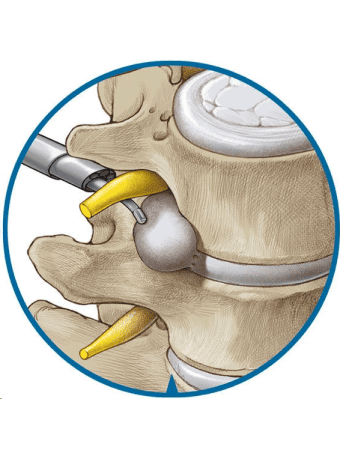
Endoscopic Lumbar Foraminotomy
- Home
- Treatments
- Endoscopic spine Procedure
- Endoscopic Lumbar Foraminotomy
A foraminotomy is a surgical procedure. It enlarges the area around one of the bones in your spinal column. The surgery relieves pressure on compressed nerves.
Your spinal column is made up of a chain of bones called vertebrae. The intervertebral discs sit above and below the flat portion of each vertebra to provide support.
Your spinal column houses your spinal cord and helps protect it from injury. The spinal cord sends sensory information from the body to the brain. The spinal cord also sends commands from the brain to the body. Nerves spread out from the spinal cord, sending and receiving this information. They exit the spinal column through a small hole (intervertebral foramen) that lies between the vertebrae.
Sometimes these openings can become too small. When that happens, the compressed nerve can cause symptoms such as pain, tingling in the arms and legs, and weakness. The exact symptoms depends on the location of the compressed nerve along the spinal column. (For example, a compressed nerve in the neck may lead to neck pain and tingling and weakness in the hand and arm.)
During your foraminotomy, your surgeon will make a cut (incision) on your back or neck and expose the affected vertebra. Then he or she can surgically widen your intervertebral foramen, removing whatever blockages are present.
FAQs Endoscopic Lumbar Foraminotomy
- Lumbar Endoscopic Foraminotomy
- Arthritis of the spine / Bone spurs
- Bulging disc / Disc herniation
- Failed back surgery syndrome
- Foraminal narrowing (foraminal stenosis)
- Spine degeneration
- Radiculitis / Radiculopathy
- Sciatica
- Spinal slippage (spondylolisthesis)
- Spinal instability
- Spinal stenosis
During endoscopic foraminotomy, the patient is brought to the operative room. Under local anesthesia, a small metal tube is inserted to the neuroforamen for direct visualization. The surgical tools are inserted through this tube so that your muscles do not need to be torn or cut open. The spinal nerve is found under direct visualization looking through the tube, and protected.
Under direct vision, bone spurs, scars, ligament overgrowth, protruded discs, and part of the troubled lumbar facet are removed with appropriate tools (eg, a laser, radiofrequency or mechanical tools) to enlarge the nerve hole and to release the compressed nerve(s). Finally, the tube is removed and the incision is closed with a stitch or two.
Upon completion, the patient is encouraged to walk around and is free to leave the center, with a companion, the same day. After a follow-up visit with the surgeon the next day, the patient can go home for a quick recovery.
Endoscopic Foraminotomy is a true minimally invasive spine procedure that includes the following advantages:
- Minimally Invasive
- Short recovery
- High Success rate
- Local anesthesia
- Minimal or no blood loss
- Preservation of spinal mobility
- Small incision and Minimal scar tissue formation
- Same day surgery with no hospitalization (outpatient procedure)
Video Spotlight
Blog
Surgery-Free Solutions
Expert Tips for Pain Management
Testimonials
Words From Our Patients
The treatment was very good and the doctor Faraz Ahmed was very kind to the patient and explained clearly the procedure of knee bilateral ha & treatment And we were advised to do physiotherapy. We are very much satisfied. We would recommend this alleviate pain clinic. Thank you
Got treatment of Treatment and HA for right knee arthritis a month ago and finding good relief from pain. Was treated by Dr Swagtesh Bastia who explained very well about the injections and the treatment was painless. The front desk staff were very kind and very helpful and physiotherapy was also done expertly, overall good experience
Alleviate Pain Management clinic has been a godsend for my mom's knee pain. She has been treated by Dr. Wiquar Ahmed. The attentive staff provided personalised care, and after her treatment, she's feeling remarkably better. Thank you for giving my mom the relief she deserves!
The clinic is super clean with a great OT and most importantly all the staff here are very helpful and considerate. My gratitude to Dr Roshan, the nurses, and support staff - they were always available to assist with any issues post procedure and they even made an extra effort to make a home visit for a follow up check-up. This team here is the perfect example of healing and care with a human touch. Thank you!!!!!
My wife had knee pain I have visited alleviate pain and consulted doc santhoshi now she is able to walk pain free and can do her daily activity than before.the physiotherapist here Dr akhila also helped her with few exercises and the staff here Abdul explained all the procedures well . Thank you PPL can visit here for pain relief





